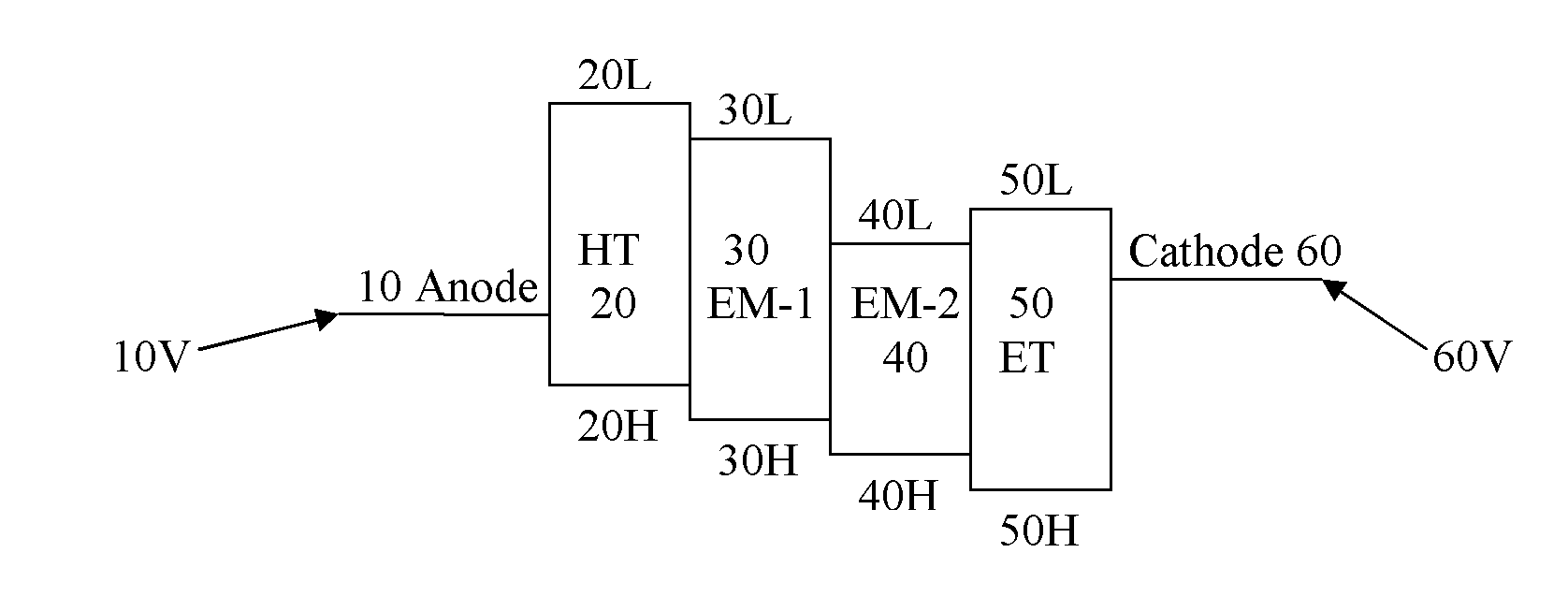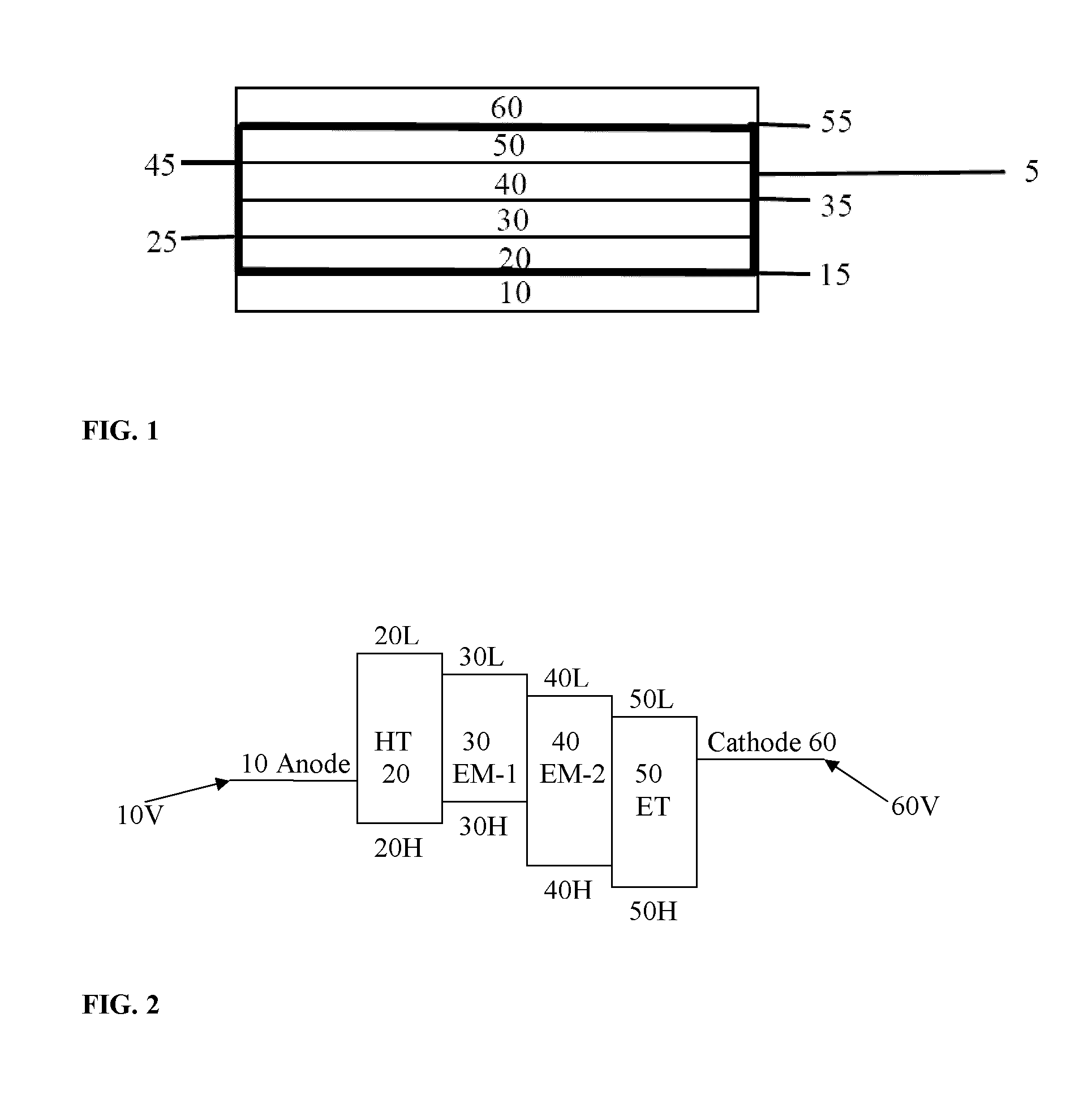Organic light-emitting diode with enhanced efficiency
a light-emitting diode and organic technology, applied in the direction of organic semiconductor devices, solid-state devices, thermoelectric devices, etc., can solve the problems of reducing device efficiency, reducing device efficiency, and adding expense and complexity to device fabrication
- Summary
- Abstract
- Description
- Claims
- Application Information
AI Technical Summary
Benefits of technology
Problems solved by technology
Method used
Image
Examples
example 1
[0062]The devices were generally fabricated as follows.
[0063]ITO coated glass substrates were cleaned by ultrasound in acetone, and consecutively in 2-propanol, baked at about 110° C. for about 3 hours, followed by treatment with oxygen plasma for about 30 min. A layer of PEDOT: PSS (Baytron P from H. C. Starck) was spin-coated at about 6000 rpm onto the pre-cleaned and O2-plasma treated (ITO)-substrate and annealed at about 180° C. for about 30 min, yielding a thickness of around 20 nm. In a glove-box hosted vacuum deposition system at a pressure of about 10−7 torr (1 torr=133.322 Pa), 4,4′4″-tri(N-carbazolyl)triphenylamine (TCTA) was first deposited on top of PEDOT / PSS layer at deposition rate of about 0.06 nm / s, yielding a 40 nm thick film. Then the first emitter (about 12% wt) with the first host was co-deposited on top of TCTA to form a 5-10 nm thick film as first light-emitting layer, followed by co-deposition of the second emitter (about 5% wt) and the second host to form a 1...
example 2
[0064]The following device, which has the conventional stepwise decrease in HOMO energy levels and LUMO energy levels, was prepared according to the procedure of Example 1.
LUMOEmissiveLayerMaterial(eV)HOMO (eV)MaterialHole-transportDTASi−2.20−5.60NAFirst light-emitting4Cz-PBP−2.60−6.06FIrPicSecond light-emitting4Cz-PBP−2.60−6.06Ir(pq)2acacThird light-emitting4Cz-PBP−2.60−6.06FIrPicElectron-transportTPBI−2.70−6.20NA
[0065]The performance of this device was evaluated by I-V measurements using a Keithley 2400 Source Meter to apply 0-10 V voltage scans and measure the current simultaneously. All device operations were done inside a nitrogen-filled glove-box. FIG. 9 is a plot of the luminance efficiency and the power efficiency of the device at varying brightness. FIG. 9 shows that the luminance efficiency generally ranges from about 28 cd / A to about 31 cd / A, and the power efficiency ranges from about 19 lm / W to about 24 lm / W, at a brightness ranging from about 200 cd / m2 to about 1,000 cd...
example 3
[0066]The following device, which has the conventional stepwise decrease in HOMO energy levels, was prepared according to the procedure of Example 1.
LUMOEmissiveLayerMaterial(eV)HOMO (eV)MaterialHole-transportDTASi−2.20−5.60NAFirst light-emittingHO-1−3.10−6.08FIrPicSecond light-emittingHO-1−3.10−6.08Ir(pq)2acacThird light-emittingHO-1−3.10−6.08FIrPicElectron-transportTPBI−2.70−6.20NA
[0067]The performance of this device was evaluated by I-V measurements using a Keithley 2400 Source Meter to apply 0-10 V voltage scans and measure the current simultaneously. All device operations were done inside a nitrogen-filled glove-box. FIG. 10 is a plot of the luminance efficiency and the power efficiency of the device at varying brightness. FIG. 10 shows that the luminance efficiency generally ranges from about 37 cd / A to about 42 cd / A, and the power efficiency ranges from about 24 lm / W to about 33 lm / W, at a brightness ranging from about 200 cd / m2 to about 1,000 cd / m2 brightness. At 1,000 cd / m2...
PUM
| Property | Measurement | Unit |
|---|---|---|
| Fraction | aaaaa | aaaaa |
| Wavelength | aaaaa | aaaaa |
| Wavelength | aaaaa | aaaaa |
Abstract
Description
Claims
Application Information
 Login to View More
Login to View More - R&D
- Intellectual Property
- Life Sciences
- Materials
- Tech Scout
- Unparalleled Data Quality
- Higher Quality Content
- 60% Fewer Hallucinations
Browse by: Latest US Patents, China's latest patents, Technical Efficacy Thesaurus, Application Domain, Technology Topic, Popular Technical Reports.
© 2025 PatSnap. All rights reserved.Legal|Privacy policy|Modern Slavery Act Transparency Statement|Sitemap|About US| Contact US: help@patsnap.com



